Hi Henrik funny you should mention Parthian swords, as I was just looking into them myself, I was actually looking for info on Sassanid swords as they definately share some characteristics with Hunnic sword. Then I found an image of one of these Parthian swords (which Sassanid sword developed from) and IMHO it looked very similar to the plainer examples of Hunnic swords.
I was doing some more looking around and I noticed that the two handed sword posted above by Till J. Lodemann seems to be very similar to some Han dynasty swords which can be seen on Thomas Chen's website (probably the best resource for chinese sword info online) here
http://thomaschen.freewebspace.com/photo.html
So there's another Chinese / Hun connection for you Paul. I think that the Huns probably started with swords very similar to those of the Han dynasty and as time went on, and as they moved westward, they adopted elements of Sassanid style swords (which they in turn also influenced), such as P shaped fittings, and possibly adornments of precious metals and stones.
Earlier on in the thread someone pointed out that there seems to be no evidence of pattern welding in these blades, I think that a comment was also made about how it was funny that a practical people such as the Huns would have beautifully decorated hilts attached to poor quality blades (btw to whoever made the above comments, forgive me if I'm miss remembering but I didn't have time to look through the whole thread)
As I'm not aware of any metalurgical study on these sword, all we can do is speculate. So, I think that there is a good chance that early Hunnic swords derived from Han dynasty swords, and if that is the case, then it is possible that the Huns also derived their smithing skills from the Han.
Sword of the Han dynasty were made using very sophisticated techniques, the chinese were using various laminations of iron and steel, along with forge folding, and differential heat treating, all of there techniques would later be transmitted to Japan, where they were made famous by way of the katana.
There was much trade between the Middle East and China during this period, as seen by the adoption of P shaped fittings on Chinese dao, so I dont think it is too far a stretch to imaging Chinese bladesmithing techniques being brought to Europe by Hunnic peoples.
Wootz steel is another possibility, as it was much traded in Asia at this time.
http://thomaschen.freewebspace.com/photo.html
So there's another Chinese / Hun connection for you Paul. I think that the Huns probably started with swords very similar to those of the Han dynasty and as time went on, and as they moved westward, they adopted elements of Sassanid style swords (which they in turn also influenced), such as P shaped fittings, and possibly adornments of precious metals and stones.
Earlier on in the thread someone pointed out that there seems to be no evidence of pattern welding in these blades, I think that a comment was also made about how it was funny that a practical people such as the Huns would have beautifully decorated hilts attached to poor quality blades (btw to whoever made the above comments, forgive me if I'm miss remembering but I didn't have time to look through the whole thread)
As I'm not aware of any metalurgical study on these sword, all we can do is speculate. So, I think that there is a good chance that early Hunnic swords derived from Han dynasty swords, and if that is the case, then it is possible that the Huns also derived their smithing skills from the Han.
Sword of the Han dynasty were made using very sophisticated techniques, the chinese were using various laminations of iron and steel, along with forge folding, and differential heat treating, all of there techniques would later be transmitted to Japan, where they were made famous by way of the katana.
There was much trade between the Middle East and China during this period, as seen by the adoption of P shaped fittings on Chinese dao, so I dont think it is too far a stretch to imaging Chinese bladesmithing techniques being brought to Europe by Hunnic peoples.
Wootz steel is another possibility, as it was much traded in Asia at this time.
Hi Stephen!
SOme nice ideas. But you shouldn't speculate so far. Have you evidence that wootz was used in the steppeworld at this period of time? I mean ok, wikipedia states that it was "widely exported" but what does this mean anyway?
Also, chinese and japanese bladesmithing techniques, as stated by you, are not as advanced or special as you might think. The same techniques exist since at least the 8th century BC in middle europe I know some early ironage Mindelheim swords from Rubenheim-Wolfersheim (Germany) that have been examined and showed the applimentation of these same techinques.
Coinincedentally I read a text about pattern welded weapons in the danish bog finds again just lately
(by Robert Thomsen, Metallografiske undersøkelser af sværd og spydspidser fra mosefundene i Illerup og Nydam, in: Aarbøger for Nordisk Oldkyndighed og Historie 1992)
Three types of blades have been identified in the bog sacrifices (always a splendid source for roman swords of the 3rd to 5th centuries). The first type doesn't show pattern welded structures and has a layered structure visible on the intersection, similar to early celtic or eastern e.g. chinese or japanese) blades.
Type 2 is thoroughly patternwelded with different kinds of patterns from stripes to some quite complicated alternations of twisted and straight.; and edges of refined steel welded on
Type 3 has only thin layers of pattern welded material welded to a refined mild steel core and hardened edges. The patterns are even more elaborate here, for example "tree pattern" - a lot of tiny trees, bit like the modern rose pattern.
I will load it up later:lol:
All of these blades are contemporal 3rd century AD
This and the metallographical examinations show that pattern welding was neither the only way to produce a quality blade nor was it superior to non patternwelded swords.
Concerning the design of long hunnish swords and Han jian swords, both certainly share some similarities in design and maybe have a common "ancestor" but they are not the same; the fittings are very different from each other.
It is possible that the hunnish swords derrive from chinese archetypes but they must have been used by the huns since the downfall of the Xiongnu.
Otherwise, the huns would also have known and used the "dao", a weapon much more usefull for a horseman.
SOme nice ideas. But you shouldn't speculate so far. Have you evidence that wootz was used in the steppeworld at this period of time? I mean ok, wikipedia states that it was "widely exported" but what does this mean anyway?
Also, chinese and japanese bladesmithing techniques, as stated by you, are not as advanced or special as you might think. The same techniques exist since at least the 8th century BC in middle europe I know some early ironage Mindelheim swords from Rubenheim-Wolfersheim (Germany) that have been examined and showed the applimentation of these same techinques.
Coinincedentally I read a text about pattern welded weapons in the danish bog finds again just lately
(by Robert Thomsen, Metallografiske undersøkelser af sværd og spydspidser fra mosefundene i Illerup og Nydam, in: Aarbøger for Nordisk Oldkyndighed og Historie 1992)
Three types of blades have been identified in the bog sacrifices (always a splendid source for roman swords of the 3rd to 5th centuries). The first type doesn't show pattern welded structures and has a layered structure visible on the intersection, similar to early celtic or eastern e.g. chinese or japanese) blades.
Type 2 is thoroughly patternwelded with different kinds of patterns from stripes to some quite complicated alternations of twisted and straight.; and edges of refined steel welded on
Type 3 has only thin layers of pattern welded material welded to a refined mild steel core and hardened edges. The patterns are even more elaborate here, for example "tree pattern" - a lot of tiny trees, bit like the modern rose pattern.
I will load it up later:lol:
All of these blades are contemporal 3rd century AD
This and the metallographical examinations show that pattern welding was neither the only way to produce a quality blade nor was it superior to non patternwelded swords.
Concerning the design of long hunnish swords and Han jian swords, both certainly share some similarities in design and maybe have a common "ancestor" but they are not the same; the fittings are very different from each other.
It is possible that the hunnish swords derrive from chinese archetypes but they must have been used by the huns since the downfall of the Xiongnu.
Otherwise, the huns would also have known and used the "dao", a weapon much more usefull for a horseman.
| Till J. Lodemann wrote: |
| Hi Stephen!
Type 3 has only thin layers of pattern welded material welded to a refined mild steel core and hardened edges. The patterns are even more elaborate here, for example "tree pattern" - a lot of tiny trees, bit like the modern rose pattern. I will load it up later:lol: |
Do you maybe have a picture of this pattern?
Here is an example of what I mean. A blade from Illerup.
 Attachment: 201.87 KB
Attachment: 201.87 KB
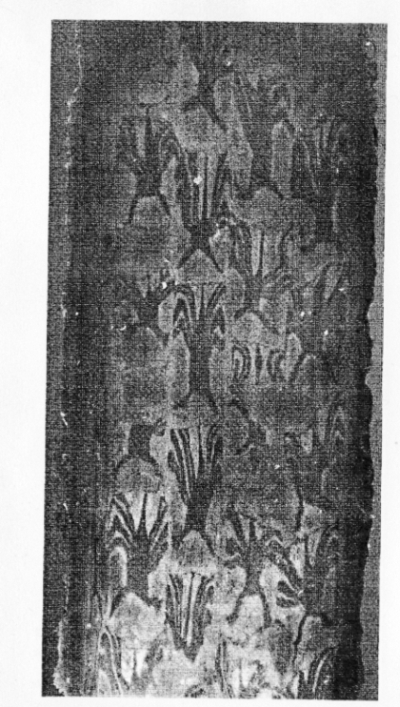
polished and etched orginal 3rd century blade
 Attachment: 186.98 KB
Attachment: 186.98 KB
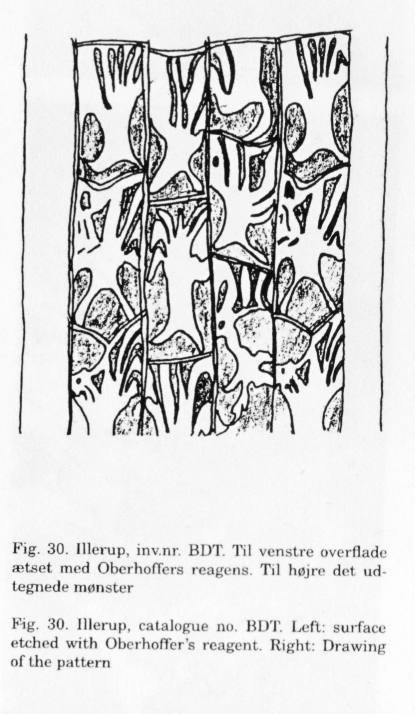
scetch of the same blade

polished and etched orginal 3rd century blade

scetch of the same blade
| Stephen Curtin wrote: |
| Sword of the Han dynasty were made using very sophisticated techniques, the chinese were using various laminations of iron and steel, along with forge folding, and differential heat treating, all of there techniques would later be transmitted to Japan, where they were made famous by way of the katana. |
Also a san-mai / laminated type of construction should show up on the surface of the blade. At least in some examples.
But all Hunnish swords I've seen seemed to be homogeneous...
| Till J. Lodemann wrote: |
| (by Robert Thomsen, Metallografiske undersøkelser af sværd og spydspidser fra mosefundene i Illerup og Nydam, in: Aarbøger for Nordisk Oldkyndighed og Historie 1992)
Three types of blades have been identified in the bog sacrifices (always a splendid source for roman swords of the 3rd to 5th centuries). |
Sounds really interesting! If you do have the opportunity to scan it, please do! :)
The pattern welding from Illerup is spectacular by the way!
| Till J. Lodemann wrote: |
| Concerning the design of long hunnish swords and Han jian swords, both certainly share some similarities in design and maybe have a common "ancestor" but they are not the same; the fittings are very different from each other.
It is possible that the hunnish swords derrive from chinese archetypes but they must have been used by the huns since the downfall of the Xiongnu. |
One interesting difference is the cross-section.
It seems that Han dynasty jians have a diamond or occasionally hexagonal/octagonal cross-section (see attachment), whereas the Hunnish swords seem to have had a lenticular cross-section, occasionally with a fuller. Of course, it could be possible that a diamond cross-section corrodes into a lenticular one... But to me, this difference seems more interesting and important than just the shape of fittings, which are easy to change and do not really alter the character of the weapon.
And the absence of a dao type weapon among the Huns is also noteworthy.
[ Download ]
| Till J. Lodemann wrote: |
| Here is an example of what I mean. A blade from Illerup. |
Very interesting, thanks!
| Till J. Lodemann wrote: |
| Here is an example of what I mean. A blade from Illerup. |
I never seen a "Tree Pattern" before. That is most stunning!
| Till J. Lodemann wrote: |
| Hi Stephen!
SOme nice ideas. But you shouldn't speculate so far. Have you evidence that wootz was used in the steppeworld at this period of time? I mean ok, wikipedia states that it was "widely exported" but what does this mean anyway? |
Depending on exactly what one means by "wootz", it might not be a matter of export, since the Central Asian crucible steel industry is old, perhaps older than the Indian industry. According to Wikipedia, there is 8th century physical evidence. At any rate, there's somewhat later evidence of large scale production (e.g., in Merv, 9th c.), and possible literary evidence (e.g., see discussion in the translation/commentary of/on al-Kindi.
A. Feuerbach, IAMS Journal 25, 27-43 (2005) has some interesting swords, e.g., KIS#2, 35r-4th century, crucible steel.
Last edited by Timo Nieminen on Fri 22 Oct, 2010 7:38 pm; edited 2 times in total
| Till J. Lodemann wrote: |
| Hi Stephen!
SOme nice ideas. But you shouldn't speculate so far. Have you evidence that wootz was used in the steppeworld at this period of time? I mean ok, wikipedia states that it was "widely exported" but what does this mean anyway? |
Well I admit that wootz may be a little unlikely but I've heard that wootz was being exported to China during this period, though I don't think that it was widely used.
| Till J. Lodemann wrote: |
| Also, chinese and japanese bladesmithing techniques, as stated by you, are not as advanced or special as you might think. The same techniques exist since at least the 8th century BC in middle europe I know some early ironage Mindelheim swords from Rubenheim-Wolfersheim (Germany) that have been examined and showed the applimentation of these same techinques. |
I was not trying to imply that East Asian sword smithing techniques were in any way superior to European techniques. I'm just saying that although no metalurgic test have been conducted, there is no reason to believe that Hunnic swords were not also of good quality.
Great discussion...
This link may be of interest considering the experimentation in pattern welding occuring in the late Roman Iron Age.
http://www.myArmoury.com/talk/viewtopic.php?t...ht=pattern
take care
ks
This link may be of interest considering the experimentation in pattern welding occuring in the late Roman Iron Age.
http://www.myArmoury.com/talk/viewtopic.php?t...ht=pattern
take care
ks
Thank you very much Kirk. A very interesting topic!
I almost forgot this pattern:
[ Linked Image ]
It's very uncommon, too.
I almost forgot this pattern:
[ Linked Image ]
It's very uncommon, too.
Good afternoon!
Here are the promissed pics. You probably already know the avar ringsword, one piece was in Kubrat's grave.
Regards:
Zoltán
 Attachment: 197.92 KB
Attachment: 197.92 KB
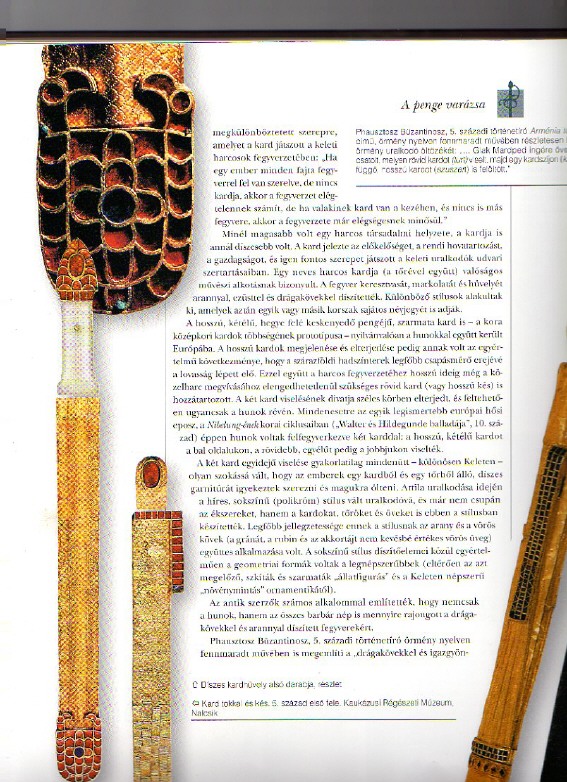
Weapons from the Caucasus
 Attachment: 197.89 KB
Attachment: 197.89 KB
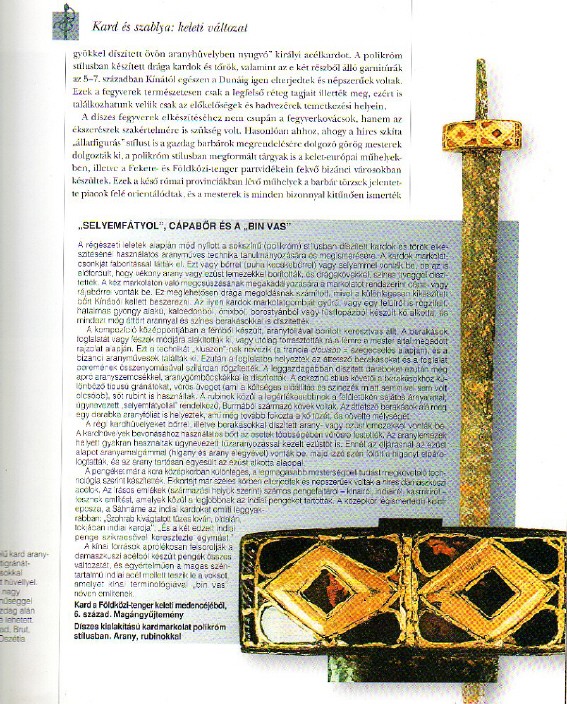
 Attachment: 233.67 KB
Attachment: 233.67 KB
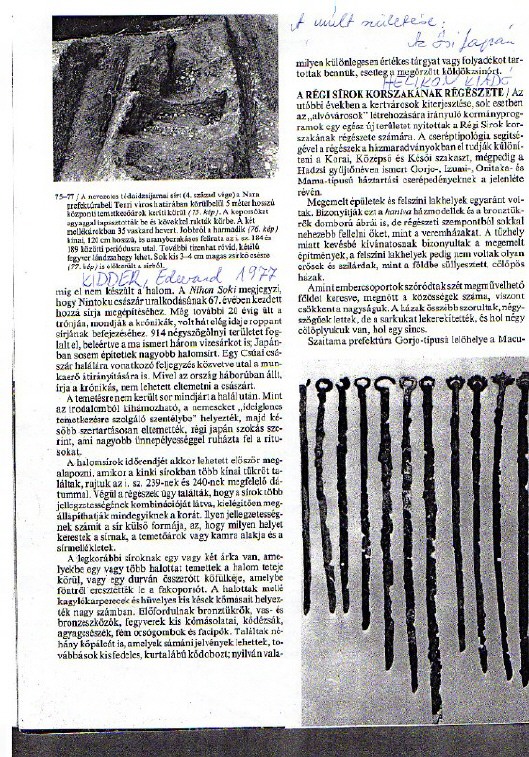
4th Century, Todaidjiyama (Nara prefect), ringswords
 Attachment: 171.8 KB
Attachment: 171.8 KB
Parthian warrior on the right; Hatra, 1-3 Th Cent. ad. [ Download ]
 Attachment: 231.54 KB
Attachment: 231.54 KB
Huang-ti's soldier from the terrakotta army [ Download ]
 Attachment: 234.14 KB
Attachment: 234.14 KB
Avar sword from Visegrád, 6-7 th Cent.; patern welded blade; [ Download ]
 Attachment: 231.79 KB
Attachment: 231.79 KB
The Visegrád ringsword [ Download ]
 Attachment: 212.44 KB
Attachment: 212.44 KB
Avar weapons in the Hungarian National Museum [ Download ]
Here are the promissed pics. You probably already know the avar ringsword, one piece was in Kubrat's grave.
Regards:
Zoltán

Weapons from the Caucasus


4th Century, Todaidjiyama (Nara prefect), ringswords
Parthian warrior on the right; Hatra, 1-3 Th Cent. ad. [ Download ]
Huang-ti's soldier from the terrakotta army [ Download ]
Avar sword from Visegrád, 6-7 th Cent.; patern welded blade; [ Download ]
The Visegrád ringsword [ Download ]
Avar weapons in the Hungarian National Museum [ Download ]
I have just found some pics of two swords that I think everyone might find interesting.
The first appears to be a Hunnic sword with silver plated hilt and garnet decorated lower guard.
http://m.flickr.com/photos/antiquitiesproject/4875389055/
The second sword has fittings decorated with gold and garnet, I'm not sure what culture it belongs to, but I remember somebody telling me that it gothic.
http://m.flickr.com/photos/antiquitiesproject/4670359307/
Also, the sword at this top of this thread, and the next one down, were on the same flickr account as these two swords. The info that goes with these swords says that they are all from 5th / 6th century Georgia (ancient Colchis), except for the second sword I posted which is from Kerch. So, providing that this info is correct, Its seems safe to say that the sword in question from the OP is indeed Hunnic.
P.S. if someone could post these pics on this thread I would be very gratefull. I would do it myself but I'm using the internet on my phone so I cant.
The first appears to be a Hunnic sword with silver plated hilt and garnet decorated lower guard.
http://m.flickr.com/photos/antiquitiesproject/4875389055/
The second sword has fittings decorated with gold and garnet, I'm not sure what culture it belongs to, but I remember somebody telling me that it gothic.
http://m.flickr.com/photos/antiquitiesproject/4670359307/
Also, the sword at this top of this thread, and the next one down, were on the same flickr account as these two swords. The info that goes with these swords says that they are all from 5th / 6th century Georgia (ancient Colchis), except for the second sword I posted which is from Kerch. So, providing that this info is correct, Its seems safe to say that the sword in question from the OP is indeed Hunnic.
P.S. if someone could post these pics on this thread I would be very gratefull. I would do it myself but I'm using the internet on my phone so I cant.
| Henrik Zoltan Toth wrote: |
| Good afternoon!
Here are the promissed pics. You probably already know the avar ringsword, one piece was in Kubrat's grave. Regards: Zoltán |
"Spits" or metal rods similar to the ones at the bottom photo brochure you posted were found at some Roman sites dated to early AD. (Finds at a temple are speculated to have been a possible offering to the local deity.) Carbon in some of these spits is consistent with 1.5% to 2% carbon content wootz, and discussion of the qualities and source of trade metals from appropriate regions was discussed in the Natural History text. It seems credible that crucible steels (maybe wootz, maybe not, but similar in strength and working requirements) existed and were traded in fairly early AD era.
Here are the two swords Stephen found at flickr:
[ Linked Image ]
[ Linked Image ]
Intersting detail on the second sword is an irregularity on the blade parallel to the upper edge, which could indicate a (roman style) bladestamp.
Jared, that sounds very interesting, can you tell more about it? Also I don't really understand to which one of Hendriks fotos you refer in your post. Do you mean the one labeled with "4th Century, Todaidjiyama (Nara prefect), ringswords"? I think these are ringswords and not spits (well, easy one as the name says it, but no other spit like objects anywere...
:confused: )
And can you tell more about the source you mentioned? And where have these spits been found?
[ Linked Image ]
[ Linked Image ]
Intersting detail on the second sword is an irregularity on the blade parallel to the upper edge, which could indicate a (roman style) bladestamp.
Jared, that sounds very interesting, can you tell more about it? Also I don't really understand to which one of Hendriks fotos you refer in your post. Do you mean the one labeled with "4th Century, Todaidjiyama (Nara prefect), ringswords"? I think these are ringswords and not spits (well, easy one as the name says it, but no other spit like objects anywere...
:confused: )
And can you tell more about the source you mentioned? And where have these spits been found?
| Till J. Lodemann wrote: |
|
Jared, that sounds very interesting, can you tell more about it? Also I don't really understand to which one of Hendriks fotos you refer in your post. Do you mean the one labeled with "4th Century, Todaidjiyama (Nara prefect), ringswords"? I think these are ringswords and not spits (well, easy one as the name says it, but no other spit like objects anywere... :confused: ) And can you tell more about the source you mentioned? And where have these spits been found? |
I mistook the Todaidjiyama "rings words" for spits, or trade iron bars. "Iron and Steel Currency Bars in Ancient Greece", by Maria Kostoglou, has some information on the subject. I would have to dig a bit if you need more. That one did turn up in internet searches just a few months ago.
| Timo Nieminen wrote: | ||
Depending on exactly what one means by "wootz", it might not be a matter of export, since the Central Asian crucible steel industry is old, perhaps older than the Indian industry. According to Wikipedia, there is 8th century physical evidence. At any rate, there's somewhat later evidence of large scale production (e.g., in Merv, 9th c.), and possible literary evidence (e.g., see discussion in the translation/commentary of/on al-Kindi. A. Feuerbach, IAMS Journal 25, 27-43 (2005) has some interesting swords, e.g., KIS#2, 35r-4th century, crucible steel. |
That is a really interesting publication! There are a few swords in there that might be Hunnish. There's even an Alan short sword!
The thing that strikes me is the extremely low hardness of many of these blades, including the crucible steel ones. KIS #2 has 220 VPH, which roughly translates to 20 HRC.
http://en.wikipedia.org/wiki/Hardness_comparison
(keep in mind that this translation is not 100% accurate due to different testing method)
Roughly similar (or higher) hardnesses are found in carburised iron blades. Some iron (ferrite) swords are so low that they fall off the HRC scale... The hardest sword in the range (KIS #8) is made from carburised iron and reaches a respectable 48 HRC, but it cracked during hardness testing...
The wootz Zschokke swords referenced to in Verhoeven's article:
http://www.tms.org/pubs/journals/jom/9809/verhoeven-9809.html
give higher hardness values: 32, 23 and 37 HRC.
All food for thought...
Anyway, it seems that the crucible steel used in these blades is not superior to the other types of blade making. Not in terms of hardness anyway.
| Henrik Zoltan Toth wrote: |
| Here are the promissed pics. |
Especially the first one is really interesting. It seems like a sister to the Pouan sax:
[ Linked Image ]
I would be really interested in hearing more about this sax!
| Stephen Curtin wrote: |
| I have just found some pics of two swords that I think everyone might find interesting. |
Thanks for the pictures! There are some more interesting swords at the same page in Flickr. Like I said in the Visigoth thread, I'm not sure that the way they layed the parts out is correct. For instance, the "pommel" seems like a sword hanger to me...
| Till J. Lodemann wrote: |
| Intersting detail on the second sword is an irregularity on the blade parallel to the upper edge, which could indicate a (roman style) bladestamp. |
Page 3 of 4
You cannot post new topics in this forumYou cannot reply to topics in this forum
You cannot edit your posts in this forum
You cannot delete your posts in this forum
You cannot vote in polls in this forum
You cannot attach files in this forum
You can download files in this forum
All contents © Copyright 2003-2006 myArmoury.com — All rights reserved
Discussion forums powered by phpBB © The phpBB Group
Switch to the Full-featured Version of the forum
Discussion forums powered by phpBB © The phpBB Group
Switch to the Full-featured Version of the forum